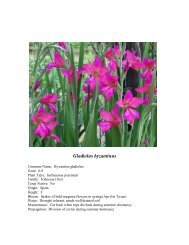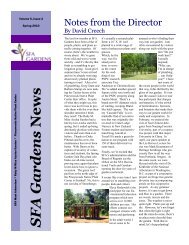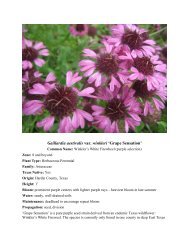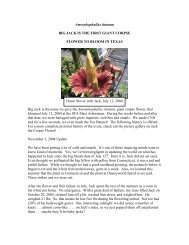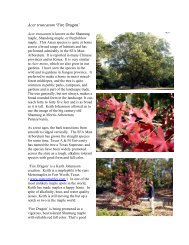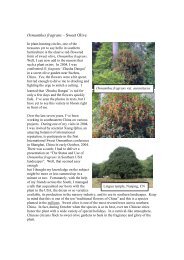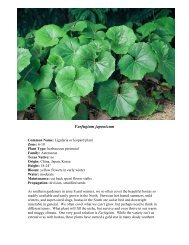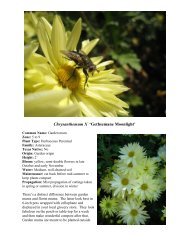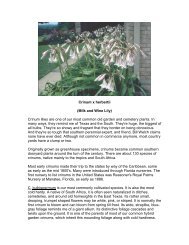Garden News - SFA Gardens - Stephen F. Austin State University
Garden News - SFA Gardens - Stephen F. Austin State University
Garden News - SFA Gardens - Stephen F. Austin State University
You also want an ePaper? Increase the reach of your titles
YUMPU automatically turns print PDFs into web optimized ePapers that Google loves.
PNPC Update<br />
By Dr. David Creech<br />
Dr. Baker Patillo and Ms. Valerie Ertz cut the ribbon<br />
at the PNPC trails dedication<br />
On April 22, 2007, the Pineywoods Native<br />
Plant Center hosted the dedication of our<br />
amazing 2.2-mile trail network and kicked<br />
off a campaign to fund the Environmental<br />
Education Center. It was a perfect night.<br />
Our guests included the <strong>SFA</strong> Board of Regents,<br />
the <strong>SFA</strong> administration, our board of<br />
advisors, and an army of supporters, volunteers<br />
and staff. While Dave Creech, James<br />
Page 4<br />
Kroll, and Mike Legg enjoyed a little time<br />
at the microphone, it was up to <strong>SFA</strong> President<br />
Baker Patillo and Valerie Ertz, Chairman<br />
of the Board of Regents, to handle the<br />
ribbon cutting. Guests enjoyed an interpretive<br />
stroll in the forest led by Elyce Rodewald<br />
and Mike Legg and learned about the<br />
PNPC, the trails, and the long range vision<br />
for this wonderful garden. A first-class<br />
dinner was followed by a presentation on<br />
the PNPC—a Dave Creech where-it’s been,<br />
where-it-is, to where-it’s-going moment.<br />
Larry Greer and the Shades of Blue Jazz<br />
Band provided the background music for a<br />
magical evening, which even included the<br />
song of a distant chuck-will’s-widow in our<br />
forest.<br />
Development Report<br />
The George and Fay Young Foundation<br />
recently awarded us a $12,500 grant for a<br />
“PNPC—Raising Awareness Program,”<br />
with two elements: completion of signage<br />
all along the PNPC trails and a “Best of the<br />
A Schima Experience in China<br />
By Dr. David Creech<br />
We’ve enjoyed Schima here and there in the<br />
Mast Arboretum and Ruby M. Mize Azalea<br />
<strong>Garden</strong> for many years. They’re attractive<br />
and durable small evergreen trees. Schima<br />
is in the Theaceae family, which means it’s<br />
kin to the camellia. It sports dark-green,<br />
bold, elliptic leaves and a show of summertime<br />
white flowers. While we have accessions<br />
that include S. argentea, S. wallichi, S.<br />
superba, and S. remoto-serrata, most botanists<br />
lump them all under S. wallichi. In<br />
spite of that, no one denies that there’s considerable<br />
variability in leaf size, tree form,<br />
and flowering. While it can reach over 100’<br />
in its home in China, Schima in our area<br />
might reach 20’ to 40’ in that many years.<br />
On a recent trip to China, I was just plain<br />
lucky to catch the species in full bloom,<br />
June 17, 2007, on a mountain road near<br />
Linhai, part of the mountainous subtropical<br />
lands near the coast. The region normally<br />
enjoys good summer rains, but springs can<br />
bring extended dry spells. Some spots experience<br />
freezes and some do not with microclimates<br />
dominating here and there. In<br />
the mountains, the natural forest cover of<br />
the region depends, of course, on elevation,<br />
aspect, and how much human interaction is<br />
going on. In many areas, it’s a broad swath<br />
of factories, businesses, apartments, road<br />
and tunnel and rail projects, all quite land<br />
changing. There are other areas – wild<br />
lands, if you will, where the native vegetation<br />
has been given a chance. The diversity<br />
really is amazing. Loropetalum and <strong>Garden</strong>ias<br />
are weeds here! Cunninghammia,<br />
China fir, dominates the mid and upper<br />
slopes. Bamboo wants to own the place. In<br />
a wide variety of habitats, Schima seems to<br />
survive quite well in forest edges, bar<br />
ditches, roadsides, and fence rows. To me<br />
it looked like a durable plant in a tough<br />
landscape. The white flowers are axillary<br />
but mostly subterminal and the blooms feature<br />
a showy center of bright yellow anthers.<br />
Mildly fragrant, the flowers were<br />
caught just coming into full bloom in mid-<br />
June in central China, and, to my surprise,<br />
the same species was in full flower June<br />
24 th in our garden – that’s about the same<br />
time. I’m not sure how significant that is,<br />
but I liked the idea. Hardiness remains a<br />
question mark simply because we’ve tested<br />
our trees only into the mid-teens. We need<br />
Best Native Plants <strong>Garden</strong>” to be designed<br />
by David and Janet Creech. Elyce Rodewald<br />
and Greg Grant have been working on<br />
the content of these signs, with advice from<br />
board member Dr. Mike Legg. The new<br />
garden will be created on a sunny knoll on<br />
the northern edge of the PNPC property and<br />
will emphasize use of colorful native perennials,<br />
shrubs, and trees.<br />
Firewise Landscape Exhibit<br />
Greg, Elyce and the PNPC student crew<br />
completed work on the Firewise Landscape<br />
Educational Exhibit this spring. Original<br />
artwork by local artist Bruce Cunningham<br />
shows examples of plants that will slow or<br />
even extinguish a wildfire, plants to avoid<br />
and how residential homeowners can create<br />
a 30-foot “defensible space” around their<br />
homes. When you visit the PNPC, be sure<br />
to look for firewise plants and new signage,<br />
in the “backyard” of the Tucker House.<br />
This public awareness project was funded<br />
by the Texas Forest Service through their<br />
some single-digit events to get a better feel<br />
for adaptation in southern landscapes.<br />
Our conclusion: This an interesting plant,<br />
one rarely encountered in southern gardens.<br />
It appears to have horticultural potential<br />
across a wide band of the South. Dr. Tom<br />
Ranney of North Carolina <strong>State</strong> <strong>University</strong><br />
has crossed Franklinia (also in the<br />
Theaceae) with Schima; I’ve seen the plants<br />
in bloom and they were quite stunning.<br />
Schimilinias! The next big question is has<br />
anyone ever crossed Schima with Camellia?<br />
Everyone will want a Schimellia, don’t you<br />
think?<br />
Schima remoto-serrata blooms in the Azalea <strong>Garden</strong><br />
GARDEN NEWS



